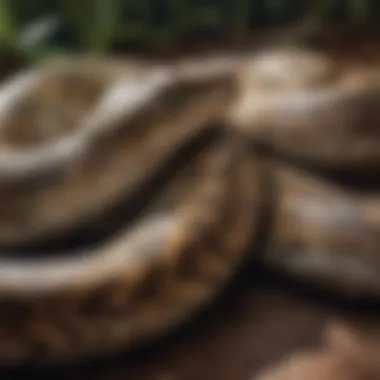The Burmese Python Invasion: A Ecological Overview


Nature Topic Overview
The voyage of the Burmese python to Florida is a striking case study in ecological disruption. Originally from Southeast Asia, this large constrictor snake has created a considerable impact on the delicate ecosystems of the Florida Everglades. This article explores the journey and the factors that transformed the Burmese python into an invasive species. Understanding this situation sheds light on the complexities of wildlife management and conservation in a rapidly changing world.
Invasive species like the Burmese python can outcompete native wildlife, leading to significant shifts in the food web. The ecology of Florida faces serious challenges as these pythons continue to expand in numbers. They have no natural predators in this region and can devour a wide range of animals, including birds and small mammals. The ecological balance is at risk due to these snakes, dramatically affecting both natural habitats and the animals living there.
Fun Facts and Trivia
Here are some intriguing facts about the Burmese python that young readers might find captivating:
- Size: Adult Burmese pythons can grow to be over 20 feet long, making them one of the largest snakes in the world.
- Diet: These pythons are non-venomous constrictors, meaning they suffocate their prey before swallowing it whole.
- Reproduction: Female pythons can lay up to 100 eggs at a time!
"Burmese pythons have been spotted over 100 miles away from where they were initially released, showing how far they can travel in search of food."
Children can engage with the topic through interactive elements like quizzes about different snake species or puzzles about the Everglades.
Wildlife Explorations
In the Florida ecosystems, various species share their habitat with the Burmese python. Examples include:
- American Alligator: This large reptile also hunts for smaller mammals and can compete with pythons.
- Eastern Indigo Snake: A native snake that plays a role in the ecosystem by keeping rodent populations in check.
Florida's unique flora and fauna highlight the importance of understanding ecological relationships. Learning more about these species can empower young people to appreciate the balance of nature.
Environmental Awareness
Conservation efforts play an essential role in addressing the challenges posed by invasive species like the Burmese python.
- Why Conservation is Important: Protecting native species helps maintain ecological balance.
- What You Can Do: Young readers can participate in local clean-up events, or support wildlife preservation organizations.
Simple actions can have a big impact on protecting wildlife. By fostering awareness among children, we help future generations appreciate and care for their environments.
DIY Nature Activities
Hands-on activities can create a deeper connection with nature. Here are a few suggestions for kids:
- Create a Nature Journal: Encourage kids to draw or write about the plants and animals they observe in their local area.
- Snake Habitat Craft: Use recycled materials to build a model of a snake’s habitat, discussing what is needed for survival.
- Outdoor Exploration: Organize a walk in a park and look for local wildlife while practicing observation skills.
These activities provide an interactive learning experience that is both educational and enjoyable.
By understanding the story of the Burmese python, we not only learn about an invasive species but also the underlying principles of wildlife management and ecological responsibility.
Prelude
The invasion of the Burmese python in Florida represents a complex interplay of human action, ecology, and invasive species management. This introduction sets the stage for understanding how these large snakes transitioned from the forests of Southeast Asia to the subtropical wetlands of Florida.
Through this article, we explore the critical elements surrounding the Burmese python's journey, emphasizing not just the arrival itself but also the broader implications for the local ecosystem. Knowing the backstory of these pythons allows us to see why they pose significant threats to Florida's wildlife. It helps readers appreciate the challenges Florida faces in managing this invasive species.
Notably, the pet trade was pivotal in introducing Burmese pythons to the United States. Many people brought these snakes home as exotic pets. However, as they grew larger and harder to manage, some were released into the wild, leading to their establishment in Florida. This is an important factor to consider when discussing the journey of Burmese pythons.


The existence of the snakes has raised concerns among ecologists and wildlife managers. Awareness of their impact on native species is crucial. In this article, we will analyze their biological characteristics, the effects of hurricanes on their population, and the ecological consequences of their presence.
The introduction of species into non-native habitats can have dire consequences, impacting both the environment and human activities.
Engaging with this narrative is valuable not just for environmental enthusiasts but for anyone interested in the impact of human decisions on nature. By delving into the specifics, we will illuminate the many factors at play in this ongoing environmental challenge.
The Origin of the Burmese Python
The journey of the Burmese python, Python bivittatus, to Florida is a significant aspect of understanding its invasion as an invasive species. Knowledge of its origin illuminates the background conditions that allowed for its establishment outside its natural habitat.
These snakes are native to a variety of regions in Southeast Asia, including countries like Myanmar, Thailand, and parts of India. Knowing where they come from helps us understand their natural behavior, habits, and preferences. Furthermore, recognizing these origins allows for better assessment of their impact on local ecosystems once they reached Florida.
Geographical Range
The Burmese python's geographical range plays a vital role in comprehending its invasive capacity. Before reaching Florida, these snakes inhabited lush tropical forests and wetlands that provided a suitable environment for their growth and reproduction. In their native range, their geographic presence spans several thousand kilometers, from the tropical forests of Southeast Asia to areas with varied weather conditions.
In Florida, the humid subtropical climate has facilitated their adaptation and survival. The warmth and availability of water, along with vegetation similar to their natives areas, allowed the pythons to thrive. The ability of these snakes to cover large territories in search of food contributes to their rapid population growth in the wild.
Biological Characteristics
Understanding the biological characteristics of Burmese pythons helps clarify how they succeeded in establishing themselves in Florida's ecosystems. These snakes are notable for their large size, typically ranging from 10 to 16 feet in length, with some individuals exceeding 20 feet. They possess a robust body that allows for considerable strength.
Burmese pythons are non-venomous constrictors. They capture prey by wrapping their bodies around it, squeezing until it suffocates, then swallowing it whole. Their varied diet includes small mammals, birds, and reptiles, making them apex predators in their non-native habitats. The versatility in diet enables them to adapt to local prey availability.
Notably, Burmese pythons can reproduce prolifically. Female pythons can lay between 20 to 100 eggs in a single clutch, significantly increasing their population in a relatively short timeframe. This rapid reproduction can lead to devastating declines in native wildlife populations.
In summary, the origin of the Burmese python encompasses aspects of geographical range and biological characteristics. Knowledge in these areas is essential to grasp the implications of their invasion in Florida and the wider ecosystem challenges that arise from it.
Arrival in the United States
The arrival of Burmese pythons in the United States marks a significant moment in the history of invasive species. Understanding the circumstances and factors that allowed these snakes to establish themselves involves analyzing both ecological and human elements. It is crucial for conservation efforts and wildlife management strategies that seek to mitigate the impact of such invasions.
The Pet Trade
Burmese pythons, originally from Southeast Asia, were introduced to the United States primarily through the pet trade. This trade has had a profound impact on the introduction of various species outside their native habitats.
- High Demand: Around the late 20th century, Burmese pythons became popular exotic pets. Their striking appearance and manageable size at a young age appealed to many pet owners.
- Care in Captivity: Many owners underestimated the eventual size and special care requirements of adult pythons, leading to inadequate housing and care.
- Abandonment: When Burmese pythons grew too large or unmanageable, some owners opted to release them into the wild instead of finding alternative solutions, contributing to their wild population growth.
- Lack of Regulations: Initially, there were few regulations governing the sale and ownership of exotic pets. This lack of oversight facilitated the influx of Burmese pythons into areas not suited for them.
- Breeding Practices: In certain conditions, these snakes were bred in captivity, leading to a higher number being available to unscrupulous sellers and contributing to overpopulation in natural environments.
As these snakes escaped or were released, they began to adapt to the Floridian environment, where they found suitable habitats to thrive. Their survival was not only a result of their biological characteristics but also the lax approaches to wildlife management regarding exotic pets.
Importantly, as the Burmese python population increased, they began disrupting local ecosystems, preying on native wildlife and competing with local species for resources. The relationship between the pet trade and invasive species like the Burmese python serves as a pertinent example of how interconnected the natural world is with human activities.
Preamble to Florida
Understanding how the Burmese python arrived in Florida is essential for grasping its ecological impact. The journey of this invasive species provides insights into the delicate balance between human activities and wildlife preservation. Florida's unique environment, with its mix of wetlands and subtropical habitats, serves as an ideal backdrop for the challenges posed by the Burmese python. This section will cover early escape incidents and the effects of hurricanes, both of which played roles in establishing this species in the wild.
Early Incidents of Escape
The introduction of the Burmese python into Florida began with the pet trade. Many individuals bought these snakes as exotic pets, unaware of their eventual size and needs. Poor management often led to their escape. In the late 1990s, several high-profile incidents drew attention. In one notable case, a python escaped its enclosure in a residential area, leading to local authorities mobilizing to capture it. Such escapes were not isolated. Over time, numerous pythons found their way into the Florida ecosystem.


Diverse factors contributed to these incidents:
- Inadequate Enclosures: Many owners did not possess proper containment methods.
- Neglect: Some owners abandoned their pets in the wild, either out of fear or inability to care for them.
- Accidental Escapes: Pythons sometimes slipped away during cleaning or transport.
These occurrences set the stage for an ecological shift, as the escaped pythons began occupying local habitats.
Hurricane Impacts
Hurricanes present another significant factor in the Burmese python invasion. These severe weather events often result in widespread destruction, which can have unintended consequences for wildlife. After hurricanes, damaged infrastructure can lead to easier access for pythons from pet trade or escaped individuals to take root in natural settings.
For instance, Hurricane Andrew in 1992 caused extensive damage in southern Florida. Reports emerged of Burmese pythons escaping from damaged facilities. Flooded areas provided perfect conditions for these snakes to thrive. They soon found an abundant food source, as local wildlife struggled to adapt to the altered environment.
The combination of escape incidents and hurricane impacts significantly contributed to the expansion of the Burmese python population. These factors illustrate the interconnected nature of human actions, environmental shifts, and wildlife developments.
Ecological Impact of Burmese Pythons
The introduction of Burmese pythons in Florida has profound effects on the local ecosystem. Understanding these impacts is essential for both wildlife management and ecological conservation. The arrival of this invasive species disrupts natural processes and poses challenges to native flora and fauna. This section will explore the threats to native wildlife and the changes in habitat dynamics.
Threats to Native Wildlife
Burmese pythons prey on a variety of animals in Florida. Their diet includes smaller mammals, birds, and even reptiles. This predation has led to significant declines in certain native species. Notable examples include the eastern cottontail rabbit, raccoons, and some bird species. As these native populations dwindle, the balance of the ecosystem shifts.
Research conducted by the South Florida Water Management District shows alarming declines in small mammal populations in areas heavily populated by pythons. The loss of these animals can create a cascade of effects throughout the food chain, impacting larger predators and even plant life.
Moreover, the ability of Burmese pythons to reproduce quickly complicates the issue. A single female can lay dozens of eggs, rapidly increasing their population numbers. A struggle for survival emerges, as local species face increased competition for resources and habitats. The resilience of the Burmese python makes it a formidable threat, one that local wildlife may not be equipped to combat.
Changes in Habitat Dynamics
The presence of Burmese pythons in Florida alters the natural habitats they invade. As these snakes adapt to their surroundings, they establish themselves in a variety of environments, including wetlands, grasslands, and even urban areas. Their adaptability allows them to thrive, but it also disrupts existing ecosystems.
One notable change includes the alteration of predator-prey relationships. Burmese pythons, as apex predators, can outcompete native species for food and territory. This imbalance can lead to shifts in prey behavior, as remaining native predators may struggle to find sufficient food. Over time, this can result in less biodiversity, as some species are pushed out of their natural habitats
Management and Control Efforts
The issue of managing and controlling the invasive Burmese python population in Florida is critical. Effective management efforts are essential to protect the native ecosystem. The presence of these non-native snakes has significantly affected the local fauna. Thus, there is a pressing need for initiatives that will mitigate their impact.
Government Initiatives
Government action plays a key role in tackling the Burmese python problem. Various agencies and organizations have developed strategies to control their numbers. The Florida Fish and Wildlife Conservation Commission has implemented programs designed to monitor and remove these pythons from the wild. A notable initiative is the Python Challenge, which invites residents and hunters to capture pythons and submit them for prizes. This program not only raises awareness but also engages the community in controlling the population.
Additionally, there is a focused effort on educating the public. Informative campaigns help raise awareness of the issues related to invasive species. Printed materials, online resources, and community workshops inform residents about the ecological risks posed by Burmese pythons. Education empowers individuals to make informed decisions, such as not releasing unwanted pets into the wild.
Community Involvement
Community involvement is essential for the success of management efforts. Local residents have a unique understanding of their environment. Engaging them in control strategies can lead to innovative solutions. Organizations like the South Florida Water Management District frequently collaborate with local communities to arrange python removal events. These initiatives encourage families and groups to actively participate in wildlife management.
Moreover, citizens can report sightings of Burmese pythons to authorities. Quick reporting helps in tracking the snake’s movements and population trends. A collective effort leads to higher success rates in capturing these snakes.
In summary, managing Burmese python populations in Florida requires both government and community support. The combination of formal programs and local participation creates a robust approach to wildlife management. With continued effort and awareness, it is possible to lessen the impact of this invasive species on Florida’s ecosystems.


Effective management strategies can change the dynamic of an ecosystem affected by invasive species.
Challenges in Addressing the Invasion
The Burmese python invasion in Florida presents a range of challenges that require urgent attention. Understanding these challenges is crucial for anyone interested in wildlife management and conservation. The presence of this invasive species affects not only local ecosystems but also raises broader implications for public health, economic stability, and biodiversity.
Public Perception and Misunderstandings
Addressing public perceptions is vital in managing the Burmese python invasion. Many people view pythons as exotic or fascinating pets. This admiration often oversimplifies the serious ecological implications of their invasion. Misunderstandings can lead to complacency, making it harder to implement effective control measures. For instance, some community members may believe that pythons are beneficial to the environment, thinking they help control smaller animal populations. However, the larger truth is that they often decimate native wildlife. Such misconceptions can hinder public support for measures aimed at reducing python populations.
Furthermore, education plays a key role in tackling these misunderstandings. Educational programs aimed at informing the public about the ecological impacts of the Burmese python can foster greater awareness. When individuals recognize that these snakes pose a threat, they might be more willing to engage in control efforts or report sightings.
"Understanding the impacts of invasive species is essential for effective wildlife management."
Environmental Factors
Various environmental factors complicate the management of Burmese pythons in Florida. Their ability to thrive in diverse habitats, such as the Everglades, poses significant challenges. The warm, humid climate of Florida creates an ideal environment for pythons to reproduce and flourish. Taming their numbers proves difficult due to factors like habitat destruction and climate change, which can further affect local ecosystems.
Additionally, the local ecosystem is not equipped to cope with the sudden influx of a predator like the Burmese python. Native species have not evolved to face such formidable competition. As pythons continue to breed and spread, they significantly disrupt food chains, leading to a cascading effect on biodiversity.
The Future of Burmese Pythons in Florida
Understanding the future of Burmese pythons in Florida is critical. This issue touches on ecological balance, wildlife conservation, and community safety. As the elephants in a room, these snakes demand our attention. What lies ahead depends on how both the environment and society adapt to their presence.
Pythons have become well rooted in Florida’s ecosystem. Their adjustments raise questions about long-term coexistence. Managing their population will require innovative and sustainable efforts to protect native species and habitats. Future strategies need to focus on science and collaboration.
Evolving Ecosystems
Ecosystems are never static. They change over time, influenced by various factors. Burmese pythons play a significant role in this dynamic. Their presence has shifted predatory relationships and food webs in Florida. Native species have taken a hit. Small mammals and birds face increased predation.
A deeper understanding of these changes is essential. The ecological role of pythons has sparked concern but also interest in their adaptability. Research may uncover new insights into how ecosystems can adjust. Preservation of Florida's native wildlife demands constant evaluation of these shifts.
Long-term Environmental Strategies
Effective management of the Burmese python situation needs clear and strategic planning.
- First, monitoring python populations is crucial. Tracking their numbers can provide data for decision-making.
- Next, public education and engagement play an important role. People need to understand the real threats posed by the snakes and how best to respond.
- Additionally, collaboration between governmental and environmental organizations could lead to essential innovation.
Ultimately, long-term strategies must be sustainable. Small, focused actions are key to achieving lasting effects. The health of Florida’s ecosystems relies on how well humans learn to balance with these invasive creatures.
"A proactive approach may lessen the damage to local wildlife while fostering community awareness."
Only time will tell how this relationship evolves. Continuous assessment and adaptation will help in navigating future challenges. The future of Burmese pythons in Florida is complex but manageable with concerted effort.
Closure
The journey of the Burmese python in Florida highlights significant ecological issues that arise from the introduction of non-native species. This article sheds light on various elements that relate to the topic, including the economic activities of the pet trade and environmental challenges resulting from their invasion.
Understanding how Burmese pythons became an invasive species is crucial. It allows stakeholders, including homeowners, wildlife enthusiasts, and policymakers, to appreciate the broader implications for Florida's unique ecosystem.
Importance of Understanding the Invasion
- Ecological Awareness: It is vital for individuals and communities to understand the impact invasive species can have on local wildlife. Burmese pythons prey on various native animals, disrupting food webs and harming biodiversity.
- Wildlife Management: Insight into the habits and reproductive rate of Burmese pythons informs management strategies. Targeted control measures can be developed to mitigate their effects on the environment.
- Community Involvement: By understanding the challenges posed by these snakes, community members can engage in conservation efforts, such as reporting sightings or participating in removal programs.
- Educating Future Generations: Knowledge about the Burmese python's impact can be integrated into educational programs. Teaching children about the importance of native species fosters environmental stewardship among young audiences.
- Long-term Environmental Strategies: Strategies implemented today can alter the trajectory of Florida's environment. Consideration of ecological factors is essential for developing sustainable solutions that protect native species.
"Effective management of invasive species requires cooperation between government agencies and local communities."
This understanding of the Burmese python invasion also invites a conversation about the responsibility of pet ownership and the implications of releasing exotic animals into the wild. By taking proactive steps, society can promote a healthier ecosystem for future generations in Florida and beyond.







